Cisco Solutions for Connected Roadways Solution Brief
Available Languages
Bias-Free Language
The documentation set for this product strives to use bias-free language. For the purposes of this documentation set, bias-free is defined as language that does not imply discrimination based on age, disability, gender, racial identity, ethnic identity, sexual orientation, socioeconomic status, and intersectionality. Exceptions may be present in the documentation due to language that is hardcoded in the user interfaces of the product software, language used based on RFP documentation, or language that is used by a referenced third-party product. Learn more about how Cisco is using Inclusive Language.
It’s more important than ever to securely connect our critical roadways and intersections infrastructure, and provide the visibility of roadways equipment and access to data that is necessary to optimize processes and pave the way to support emerging and innovative vehicle technologies including Cellular Vehicle-to-Everything (C-V2X) communication.
Departments of Transportation (DOTs), roadway authorities and cities around the globe are focusing on enhancing the safety of road users, especially vulnerable road users, reducing traffic congestion, and achieving climate change and sustainability goals. To meet these objectives, it’s more important than ever to securely connect our critical roadways and intersections infrastructure, and provide the visibility of roadways equipment and access to data that is necessary to optimize processes and pave the way to support emerging and innovative vehicle technologies, including Cellular Vehicle-to-Everything (C-V2X) communication. Equipment including video surveillance and detection systems, weather information systems, LiDAR, and radar systems collect data about road and traffic conditions and can detect vulnerable road users. This data can be leveraged to control dynamic message signs, traffic controllers, and alert systems to reduce congestion and increase safety.
In this brochure, we will discuss how a secure, resilient, agile network can help traffic operators achieve their goals. With Cisco’s solutions, DOTs, roadway authorities, and cities and counties can successfully digitize to achieve their most important business outcomes—and build a foundation for future growth and innovation.
Challenges and opportunities for transportation professionals
Transportation, including roads and highways, is one of the critical infrastructure sectors identified by America’s Cybersecurity and Infrastructure and Security Agency (CISA) and the EU NIS2 Directive. Roadways infrastructure faces constant cyber and physical security risks. And as more Intelligent Transportation Systems (ITS) are connected, the attack surface dramatically increases. End-to-end protection against cybersecurity threats is essential for these connected systems. Therefore, traffic operations teams require visibility of everything connected at the roadside, and assurance that assets cannot be tampered with. They also have to comply with ever more stringent cybersecurity regulations such as US TSA and EU NIS2.
A secure architecture requires a scalable, multi-layer approach to ensure the physical security of connected equipment at the intersection, together with network port-level security, network segmentation support, and application-level security. It should also provide secure control of access to connected devices for maintenance, troubleshooting and upgrades. To meet these needs, DOTs and roadway operators need a solution that leverages all layers of security to protect equipment, applications, data, and people.
Traffic operations teams are contending with limited resources, and need to minimize outages while ensuring compliance with organizational policies. To successfully drive digital transformation, they need complete solutions that meet the needs of all their stakeholders.
What’s driving roadway digitization
As traffic operations and road user needs evolve, there is increasing focus on digitization of roads, highways and intersections. DOTs, roadway authorities, and cities and other transportation agencies are looking for solutions to help them modernize their highways, bridges and tunnels, as well as securely scale roadside digital infrastructure. They are seeking to drive more efficient, resilient, and sustainable traffic operations— and to build a foundation that will enable innovation. Their initiatives include:

Roadway modernization
To provide a safe and modern road user experience, connecting more Intelligent Transportation Systems (ITS).

Electrification
Addressing sustainability and climate change goals, driving an increased need for scalable charging infrastructure.
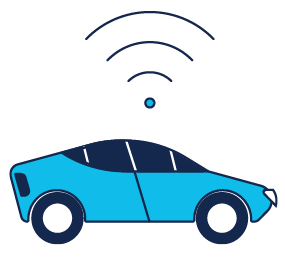
Connected vehicles
Leveraging the benefits of connected car technologies, such as autonomous driving and vehicle-to-everything communication, accelerating infrastructure investment.
Solution for connected roadways
Cisco, a global leader in industrial networking, offers a wide range of solutions to help you securely connect roadways infrastructure to enhance road user safety and meet climate change and sustainability goals. Our proven, tested designs and solutions help you create a secure digital infrastructure that can help increase operational efficiency and reduce costs, while providing a foundation to support emerging vehicle technologies like C-V2X.
Cisco understands the challenges that roadway owner-operators face and has extensive experience in the industry. Our validated solutions help organizations to securely connect critical roadway and intersection infrastructure at scale and support the successful digital transformation of roads, highways and intersections, while paving the way for new innovations.
Our solutions for roadways combine secure, reliable, scalable, high bandwidth, low latency communication with multi-level end-to-end security. They offer fixed, cellular, and wireless options to support remote locations, and enable data collection and processing at the edge.
Security is key, and we provide solutions that help protect roadways infrastructure by providing visibility into all connected roadside devices and their security posture, together with network segmentation, and in-built Next-Generation Firewall (NGFW) capabilities, and secure remote access. Operational efficiency can be optimized with centralized management and configuration of industrial devices, and policy management.
To minimize complexity and space requirements, support for ITS visibility, security and data collection capabilities are built into the industrial routers and switches themselves—with no additional hardware required. To provide the resilience required for roadside locations, Cisco’s industrial network products provide vibration and shock resistance and are built to withstand extreme temperature and humidity fluctuations.
Let’s take a closer look at some of the many use cases for Cisco’s solutions for connected roadways and intersections.
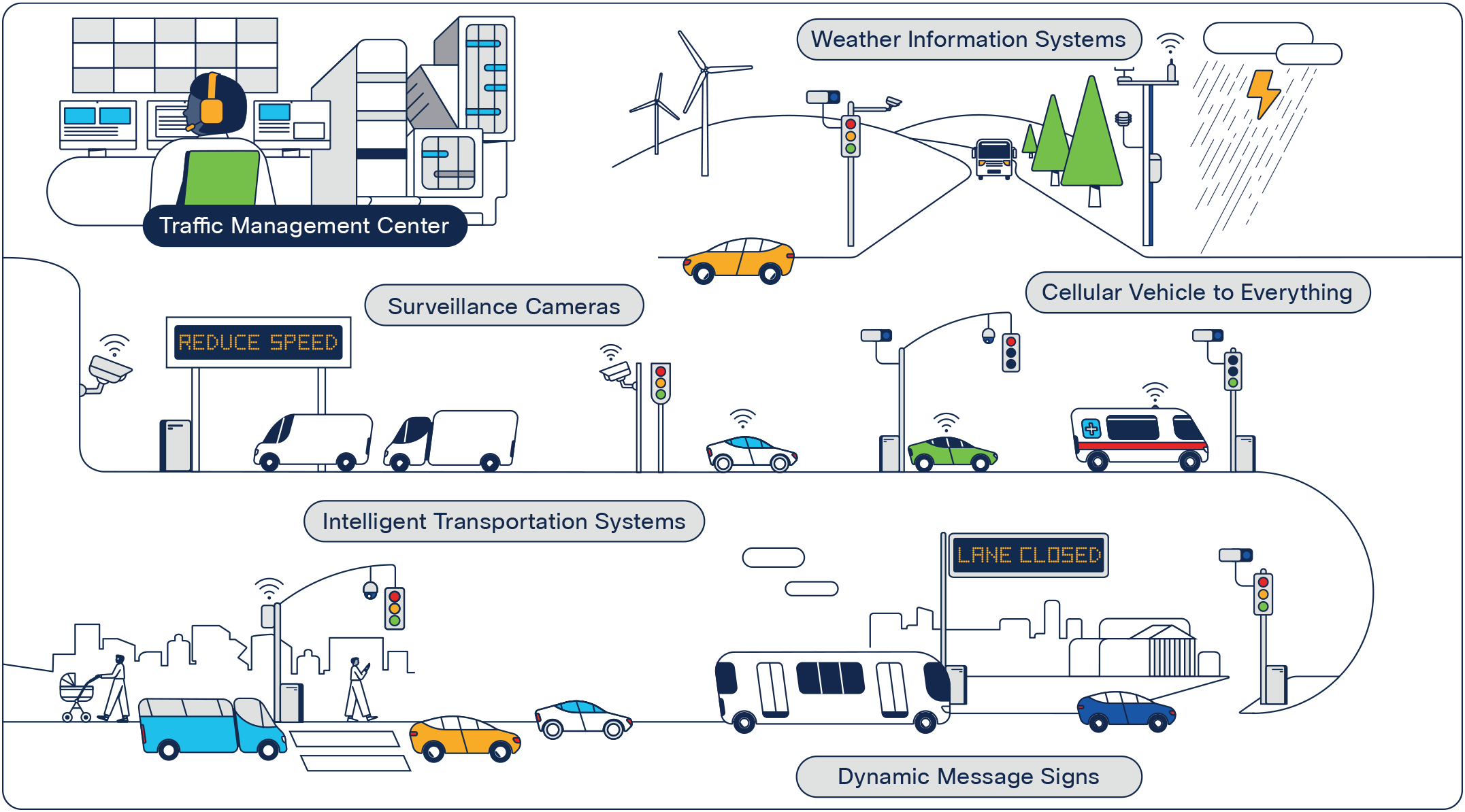
Connected roadways and intersections use cases
Connected Intelligent Transportation Systems (ITS)
Connecting ITS equipment at intersections and the roadside is key to reducing accidents and fatalities, reducing congestion, and achieving sustainability goals. It also helps boost operational efficiency and reduce costs. Equipment and systems like traffic signal controllers, surveillance and detection cameras, weather information systems, Wi-Fi access points, and digital signage need to be connected reliably and securely. This enables data from these systems to be leveraged to gain insights to help with process optimization and enhance the flow of traffic.
However, systems can number in the thousands, and fiber may not be available at every location, so cellular or wireless connectivity may also be required. And managing and maintaining everything remotely can be challenging and expensive.
Network devices providing connectivity need to be able to withstand extreme temperature and humidity fluctuations and be compact enough to fit inside roadside cabinets. And the more connected equipment you introduce, the greater the potential cyber risk.
Challenges
● Lack of availability of connectivity and space at the roadside and at intersections.
● Risk of cyber attacks due to lack of visibility into connected devices and their security posture, limited physical security in roadside locations and lack of control of external access to equipment.
● Outages and delays in troubleshooting and maintenance due to lack of awareness of issues with connected equipment.
● Expensive and time-consuming truck rolls for maintenance and troubleshooting of connected equipment.
Benefits of Cisco solution
● Scalable, modular fiber, wireless, and cellular solutions in compact, ruggedized form factor for connecting systems at the roadside and at intersections.
● Visibility of everything connected to your network, and zero trust remote access, embedded in switches and routers.
● Advanced network security with Next Generation Firewall (NGFW) and intrusion protection (IDS/IPS) features to keep roadway assets safe from cyber threats.
● Support for centralized management and configuration of industrial devices in the transportation management center to help simplify operations.
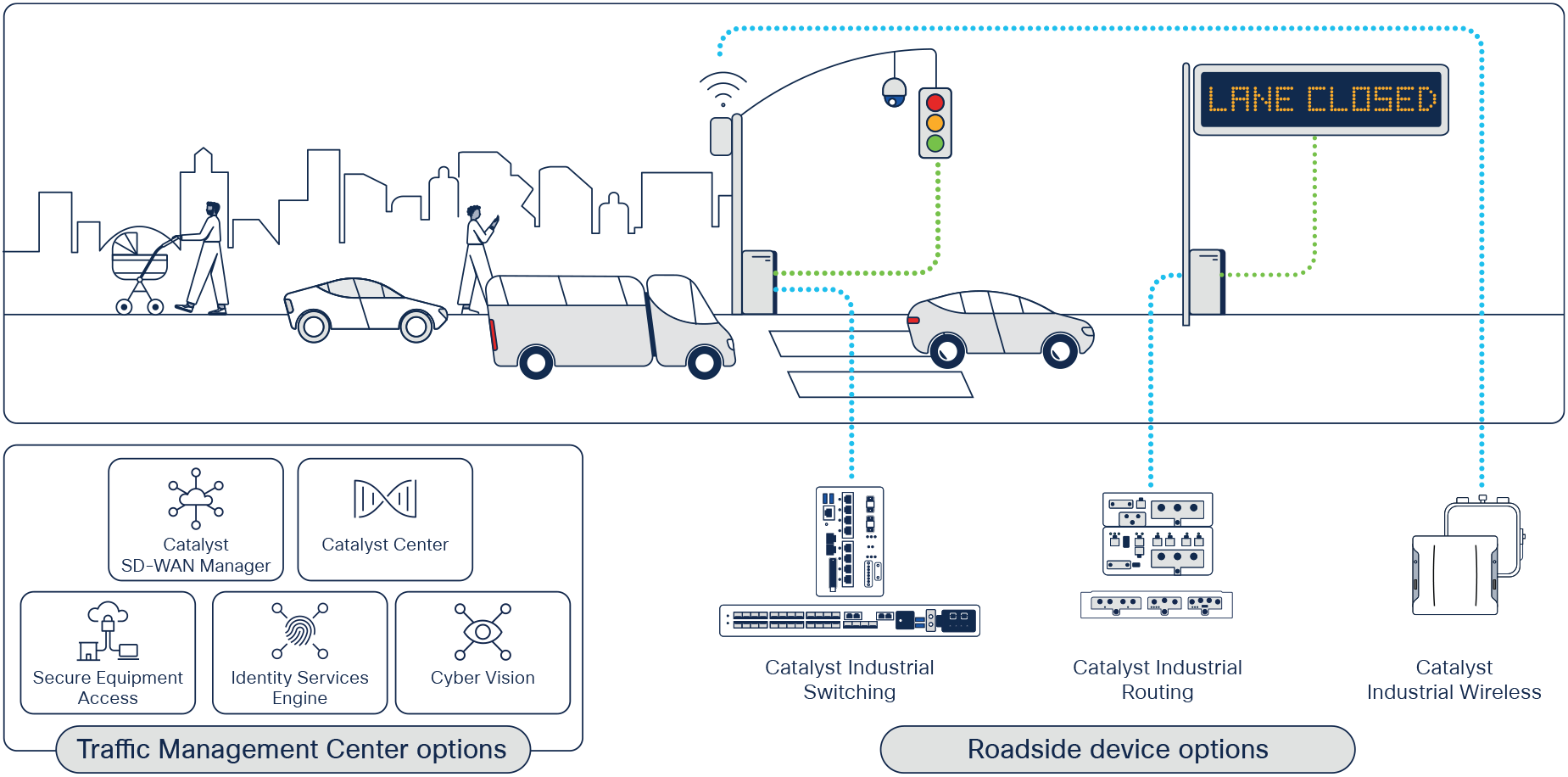
Cisco solutions for connected ITS
Cellular Vehicle to Everything (C-V2X)
Supporting new innovations like C-V2X communication and Connected Autonomous Vehicle (CAV) corridors requires numerous systems and equipment, including LiDAR, radar, cameras and sensors, Roadside Units (RSUs), and traffic controllers to be connected. Connectivity must be secure, reliable and scalable, and support high bandwidth, lowlatency communication.
Minimizing latency is important as communication delays can have a major impact. For example, agencies need to know immediately if an emergency vehicle needs priority at an intersection and have visibility of local congestion. Access to data, which needs to be collected and processed quickly to support a wide range of use cases including wrong way driver or curb speed warning applications is also necessary. And, with increased connectivity, cybersecurity is key.
Challenges
● Lack of availability of connectivity and space at the roadside and at intersections.
● Need to support corridors of intersections to allow seamless travel.
● The potential impact of cyber attacks which could be catastrophic.
Benefits of Cisco solution
● Secure reliable, scalable, high bandwidth, low latency communication that scales to support multiple intersections, with vehicles able to travel seamlessly for long distances.
● Visibility of everything connected to your network, and zero trust remote access embedded in switches and routers.
● Reduced latency with local collection of data from LiDAR, radar, and other sensors.
● Small form factor ruggedized hardware which fits easily inside the roadside cabinet.
● Centralized management and configuration of devices and security policies to help simplify operations.
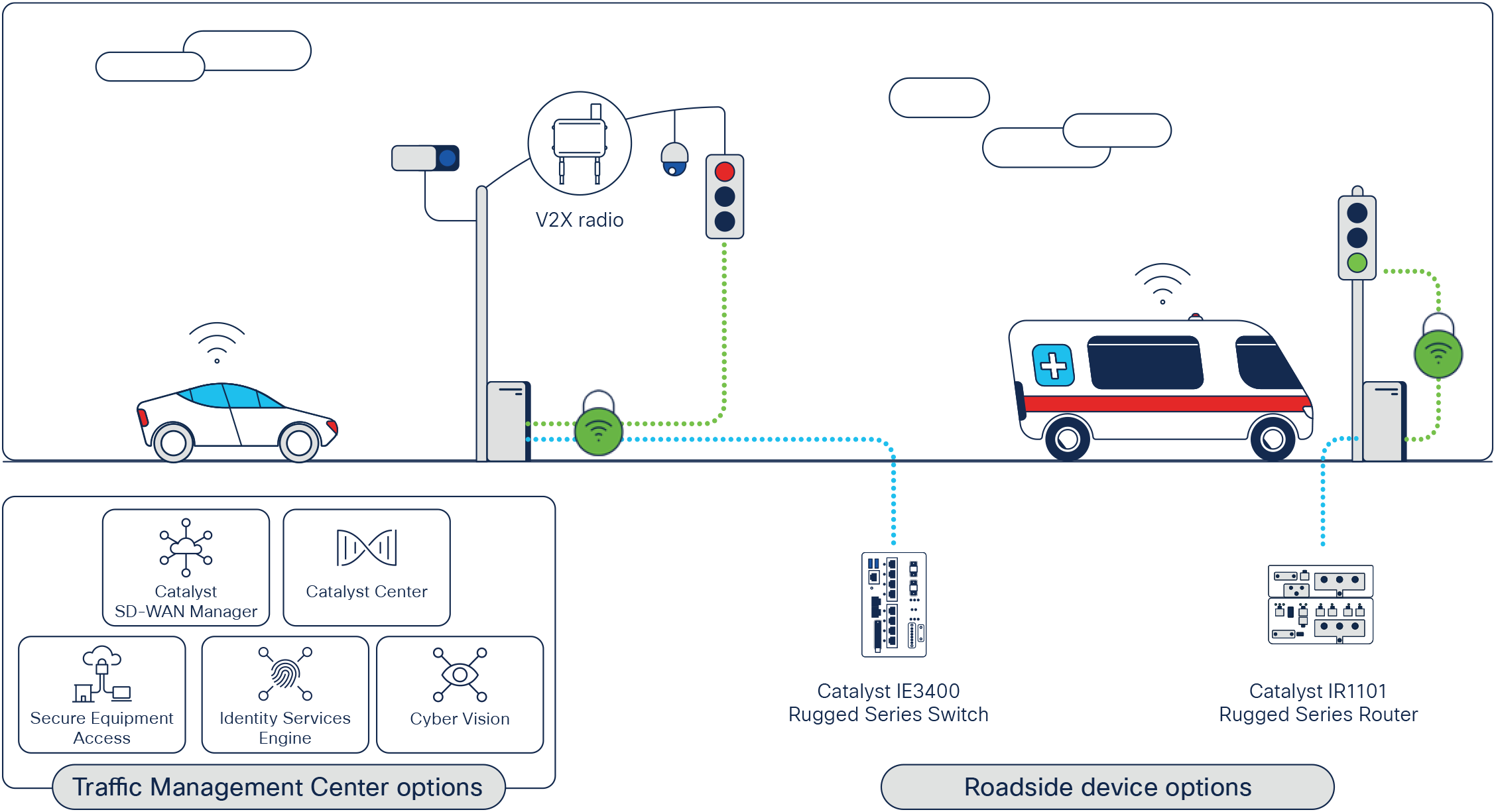
Cisco solutions for C-V2X
To help drivers get where they need to, safely and efficiently, DMSs, variable message signs and changeable message signs help to optimize traffic flow by providing alerts, warnings and general information to support a wide range of use cases including wrong way driver or curb speed warning applications and general traffic condition information.
Message signs require significant investment to deploy, and connectivity to message signs must be secure, reliable and low latency to ensure that the messages shown are timely and accurate. To protect signs from tampering, security is essential. For example, if a sign displays the wrong message, fatalities could result. And signs may be in difficult-to-reach locations, making them challenging to troubleshoot and upgrade.
Challenges
● Lack of availability of low latency, high bandwidth secure and reliable connectivity to message signs in diverse remote locations.
● Risk of cyber attackers hacking into signs.
● Lack of space to accommodate equipment and the risk of damage to network devices due to extreme temperature and humidity fluctuations.
Benefits of Cisco solution
● High bandwidth, secure and scalable cellular, wireless and fiber connectivity at the roadside with the small form factor required to fit inside a roadside cabinet.
● Zero-trust remote access embedded in switches and routers, to let operations staff remotely configure and monitor signs securely without the need to deploy point hardware solutions. Operators and vendors can securely connect, provision, and monitor DMSs remotely.
● Access to data, with collection and processing on the network device, with support for the NTCIP 1203 protocol required for DMS communication.
● Centralized device management and configuration for devices and security policies help simplify operations.
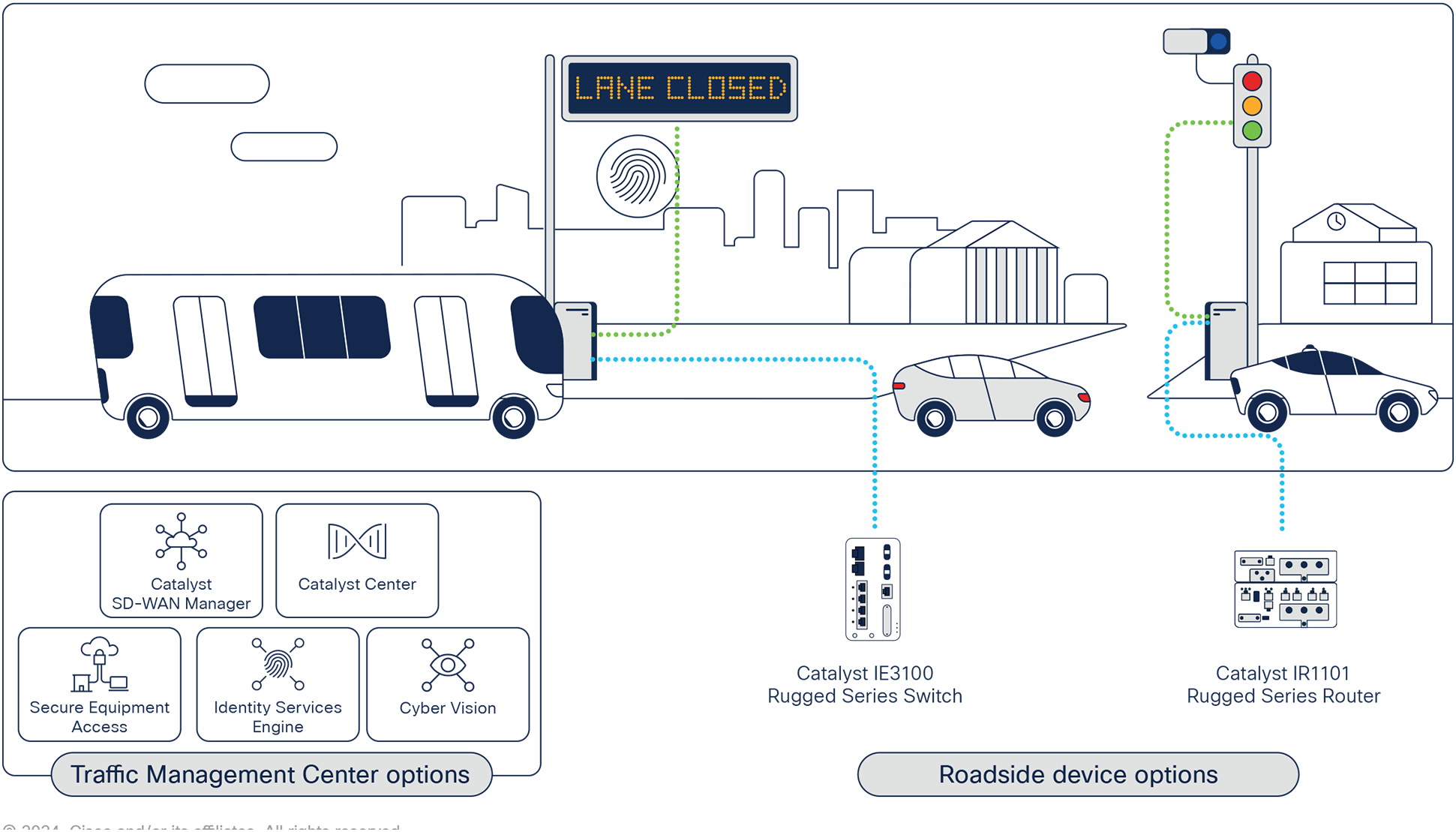
Cisco solutions for DMSs
Rural Remote Weather Information Systems
Real-time updates from weather information systems, especially those in remote, rural areas, can help transportation agencies enhance safety, reduce congestion and improve travel times. They provide the data needed to help divert drivers and other road users away from areas experiencing bad weather such as fog, ice and snow or even extreme heat.
Secure, reliable connectivity is needed to ensure that updates are provided to the traffic management center quickly and accurately.
Challenges
● Lack of access to data about extreme weather conditions to help inform road users.
● Lack of connectivity, with fiber unavailable in many rural areas.
● Remote, harsh locations and lack of space for roadside equipment.
● Specific protocol (NTCIP1204) support required to collect data from weather information systems.
Benefits of Cisco solution
● Secure, scalable cellular connectivity in a small form factor that’s easy to install in remote locations and is built to withstand harsh weather conditions.
● Local collection and processing of data, with support for NTCIP1204. This reduces latency and increases the speed of updates to traffic management centers and signage to enable timely alerts to be provided.
● Centralized management and configuration of devices and security policies to help simplify operations.
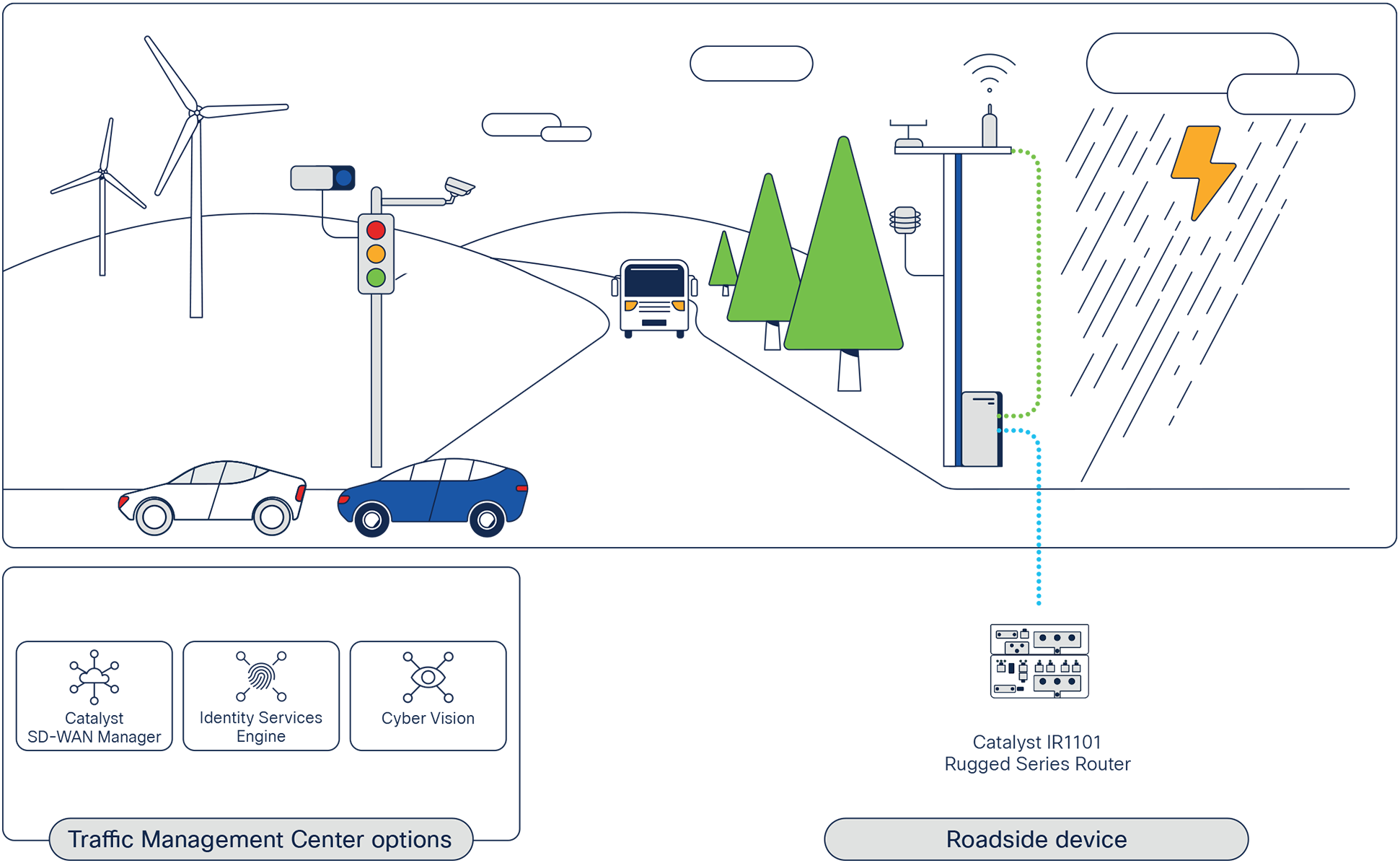
Cisco solutions for remote weather information systems
Video Surveillance and Monitoring
The ability to monitor an intersection or roadway area is critical for real-time situational awareness. Video surveillance cameras can capture live video streams on demand, assess them for immediate response, and store for future review and analysis. Increasingly, cameras can carry out analytics directly on the captured video stream without the need to forward video to a separate system. Real-time footage of pedestrian, cyclist, and vehicle activity around an intersection or other roadway focus area can be analyzed to identify vulnerable pedestrians and provide alerts to prevent accidents and improve traffic flow.
Secure connectivity and the prevention of remote access to cameras by cyber attackers are extremely important to prevent tampering which could cause accidents and fatalities. In remote locations, power sources for cameras may also be scarce.
Challenges
● Lack of visibility of pedestrians, traffic and congestion, accidents and traffic violations in real time.
● Lack of connectivity to cameras across a wide geographic area to support live streams.
● Risk of cyber-attacks on cameras or manipulation of video data.
● Lack of availability of power sources 24x7 in remote locations.
Benefits of Cisco solution
● Secure, high bandwidth, scalable and high-density connectivity with up to 90W Power over Ethernet (PoE) per port.
● Wireless connectivity to support camera deployment where fiber is not available.
● Visibility of connected assets and their security posture and zero-trust remote access to cameras and other connected assets for remote configuration and maintenance without the need to deploy point hardware solutions.
● Support for connectivity and collection of data to enable use cases such as number plate recognition, red light camera, allowing certain cars to merge, and tolling.
● Centralized management and configuration of devices and security policies to help simplify operations.
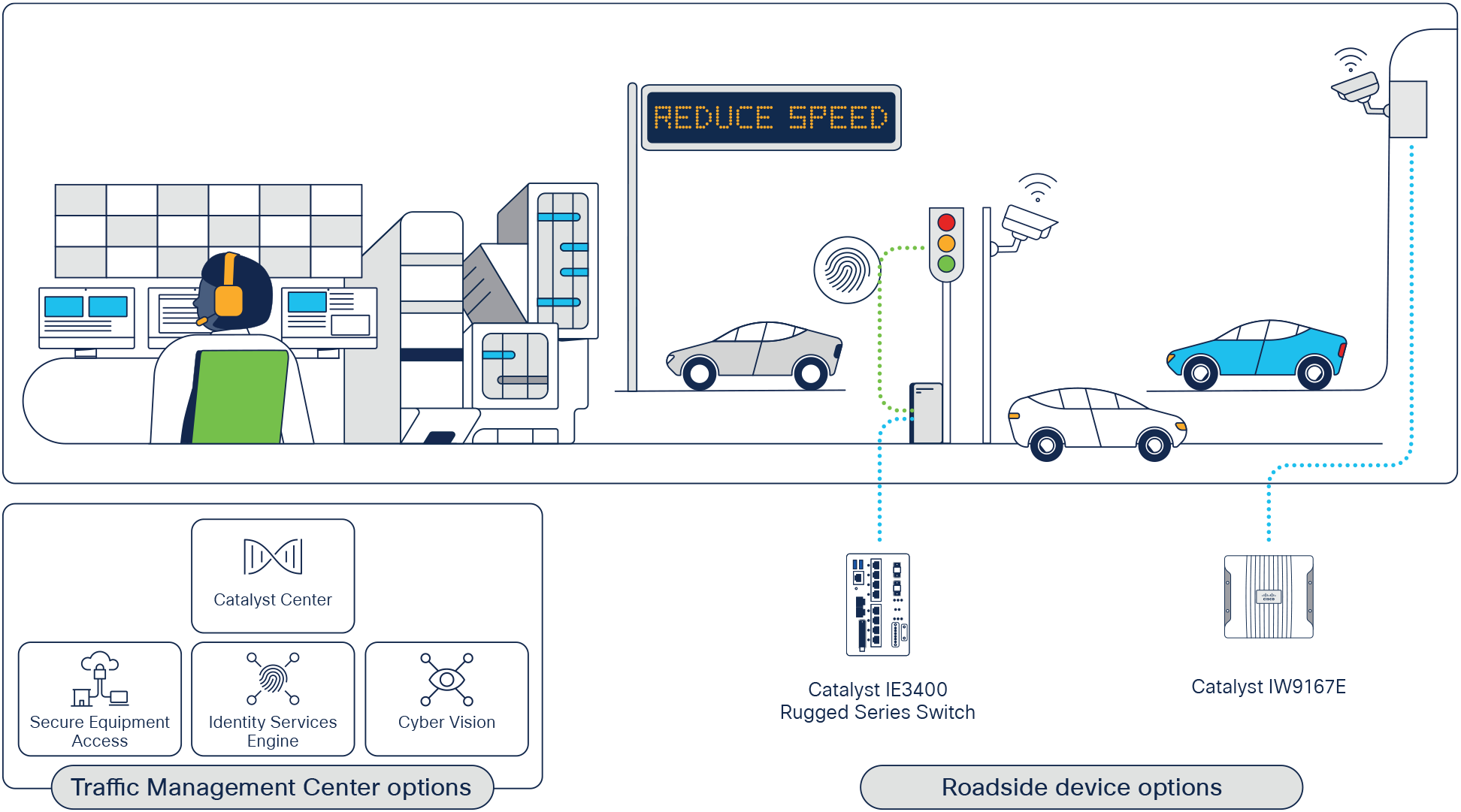
Cisco solutions for video surveillance and monitoring
Cisco portfolio for connected roadways and intersections
Cisco’s solutions for connected roadways and intersections deliver secure, reliable, scalable connectivity with multi-level end-to-end security, and include fixed, cellular, and wireless options. Security and data extraction capabilities are delivered by Cyber Vision, Secure Equipment Access and Edge Intelligence, which are built into the industrial routers and switches themselves. To reduce complexity, there is no need to deploy additional hardware solutions to provide these capabilities.
Explore the product portfolio
Cyber Vision is a software feature embedded into network equipment offering full visibility into connected roadways equipment and their security posture. It enables traffic operations to maintain a detailed inventory of ITS devices so they can drive network segmentation policies, detect malicious traffic and anomalous behaviors, helping them to ensure integrity and regulatory compliance.
Secure Equipment Access (SEA) is a zero-trust remote access solution embedded into network equipment to simplify deployment at scale without the need for extra appliances. It enforces least-privilege access controls to protect infrastructure while enabling remote technicians to access only the roadside equipment they need, and only when needed.
Edge Intelligence enables extraction of data from connected roadside equipment, transformation and governance of the data, and transfer to upstream applications. It supports a range of industry-standard connectors typically found in connected roadways and intersections solutions including OPC UA, MQTT and NTCIP 1202-1204.
Catalyst SD-WAN Manager lets you easily deploy, secure, and manage the WAN infrastructure connecting your ITS equipment, at the roadside and at intersections and to the traffic management center. It centralizes and automates network management so you can scale, and manages firewall rules enforced by your Cisco industrial routers to unify security policies and eliminate gaps in defense.
Catalyst Center enables you to connect, secure and automate network operations for your industrial switches. It helps to reduce operational costs with capabilities including AI assisted workflows and assurance, and centralized management of industrial switches to simplify operations.
Identity Services Engine (ISE) enables micro-segmentation at the device level, and fine-grained access control per user and device. Cisco ISE provides the policy engine for users and assets that require access to the your network.
It enables you to secure every port of your roadside networking equipment to ensure only the devices you trust can connect and that they can communicate only with the resources they need to.
Cisco portfolio for connected roadways and intersections
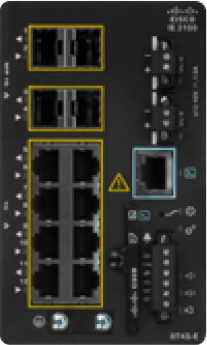
Catalyst IE3100 Rugged Series switch
Ultra-compact form-factor fixed DIN rail switch with 6, 10, 12, or 20 ports and PoE.
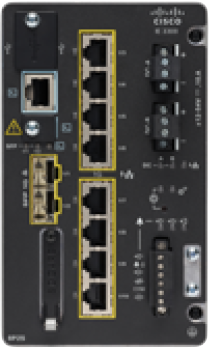
Catalyst IE3300 Rugged Series switch
All Gigabit Ethernet platform with 10G uplink connectivity with flexibility to expand to up to 24 ports, with PoE.
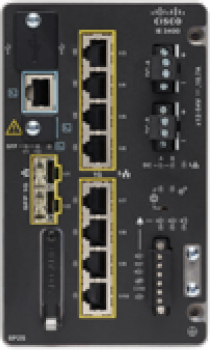
Catalyst IE3400 Rugged Series switch
Modular, compact DIN rail switch which features up to 480W PoE/PoE+ across 24 ports and resilient ring connectivity.
![]()
Catalyst IE9300 Rugged Series switch
Aggregation and fiber backhaul for multiple Catalyst access rings offering 10G uplink capacity for high bandwidth backhaul to the traffic management center.
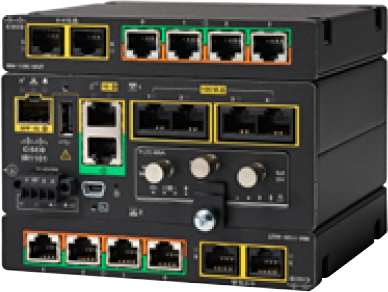
Catalyst IR1101 Rugged Series router
Highly modular, expandable router enabling a choice of connectivity including public and private 5G and LTE, and advanced firewalling capabilities.
![]()
Catalyst IR1800 Rugged Series router
Securely connect your roadside assets with 5G and Wi-Fi 6.
Enable your critical services with dual simultaneous 5G cellular support, Next-Generation Firewall (NGFW) capabilities, and more.
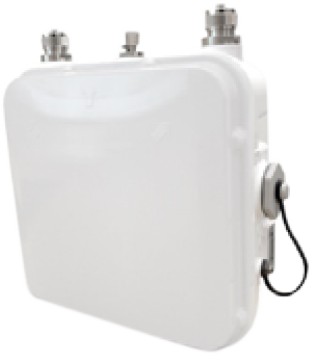
Catalyst IW9165D Wi-Fi 6/6E access point or Ultra- Reliable Wireless Backhaul
Dual-radio 2x2 access point with integrated antennas for easy deployment in a heavy-duty, IP67 certified enclosure deployable in a range of roadside locations. A wide range of external antennas can be added if needed.
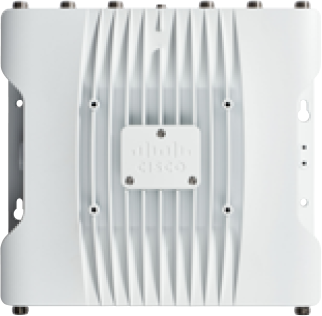
Catalyst IW9167E Wi-Fi 6/6E access point or Ultra- Reliable Wireless Backhaul
Tri radio 4x4 access point designed for high performance wireless connectivity for fixed and mobile assets at the roadside or intersection in a heavy-duty, IP67 certified enclosure.
Only Cisco provides a full portfolio of solutions that deliver the security, scale and simplicity you need for connected roadways and intersections. Our solutions enable you to:
Secure your critical infrastructure
Keep your roadside infrastructure secure with proven solutions for visibility and policy enforcement.
Increase safety and address congestion
Digitize your ITS with high bandwidth, flexible connectivity to protect road users and control traffic flow.
Drive C-V2X and innovate
Create a solid foundation to enable, scale, and support new applications, with proven solution designs.
Enhance sustainability and reduce emissions
Provide the access to data needed for insights to reduce congestion and travel time and optimize traffic flow.
Connected Roadways and Intersections